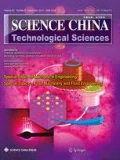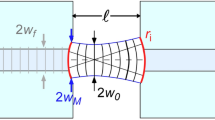Abstract
Air-core photonic bandgap fiber (PBF) is the perfect choice of the next-generation fiber optical gyroscope (FOG), with excellent temperature, electromagnetism and radiation adaptability. Numerical aperture is an important optical parameter of PBF for application in FOG. The PBF’s maximum theoretical numerical aperture (NA max) is calculated and compared with the far-field numerical aperture (NA eff) through experiments. The result indicates that the relationship between NA max and NA eff has much stronger dependence on wavelength than that of the conventional fiber, and they get close at wavelengths near the middle of the photonic bandgap with the error less than 5%. Furthermore, photonic bandgap fiber optical gyroscope (PBFOG) with no fusion splicing points is proposed, and the optimization method and results of the PBF’s structure parameters for application in PBFOG are given from the aspect of numerical aperture.
Similar content being viewed by others
References
Lefèvre H C. The Fiber-optic Gyroscope. Boston: Artech House, 1993
Kim H K, Digonnet M J F, Kino G S. Air-core photonic-bandgap fiber-optic gyroscope. J Lightwave Technol, 2006, 24: 3169–3174
Digonnet M, Blin S, Kim H K, et al. Sensitivity and stability of an air-core fibre-optic gyroscope. Meas Sci Technol, 2007, 18: 3089–3097
Yablon A D. Optical Fiber Fusion Splicing. Berlin: Springer, 2005
Guo Y Y. Experimental and theoretical investigation on numerical aperture and mode field diameter of PCF. Dissertation for the Master’s Degree. Yanshan: Yanshan University, 2009
Mortensen N A, Folkenberg J R, Skovgaard P M W, et al. Numerical aperture of single-mode photonic crystal fibers. IEEE Photonic Tech L, 2002, 14: 1094–1096
Digonnet M J F, Kim H K, Kino G S, et al. Understanding air-core photonic-bandgap fibers: Analogy to conventional fibers. J Lightwave Technol, 2005, 23: 4169–4177
Poletti F, Petrovich M N, Amezcua-Correa R, et al. Advances and limitations in the modeling of fabricated photonic bandgap fibers. In: Optical Fiber Communication Conference. Anaheim, CA, 2006
Skorobogatiy M, Yang J K. Fundamentals of Photonic Crystal Guiding. Cambridge: Cambridge University Press, 2009
Specifications for optical fibre test methods-Part 43: Measurement methods and test procedures for transmission and optical characteristics-Numerical aperture. GB/T 15972.43-2008
Gauvreau B, Desevedavy F, Guo N, et al. High numerical aperture polymer microstructured fiber with three super-wavelength bridge. J Opt A: Pure Appl Opt, 2009, 11: 1–9
Gloge D, Marcatili E A J. Multimode theory of graded-core fibers. Bell Syst Tech, 1973, 52: 1563–1578
Author information
Authors and Affiliations
Corresponding author
Rights and permissions
About this article
Cite this article
Xu, X., Gao, F., Zhang, Z. et al. An investigation of numerical aperture of air-core photonic bandgap fiber. Sci. China Technol. Sci. 58, 352–356 (2015). https://doi.org/10.1007/s11431-014-5724-9
Received:
Accepted:
Published:
Issue Date:
DOI: https://doi.org/10.1007/s11431-014-5724-9




